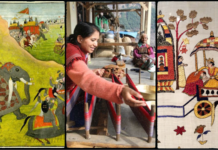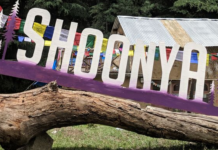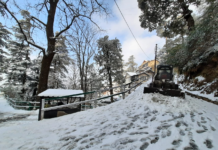
At last it is the time of the year we all have been waiting for the whole year. Diwali is here!!! But this time with a twist. We all know of the partial ban on firecrackers, the life of the party and the gradual shift back towards the traditional rituals like preference of diyas over electric lightings. So here is another thing you can add to that list to make up for losing crackers that is to love and respect all beings. And yes, by all beings we mean all beings. This is a ritual practised all over Nepal. Diwali, or Tihar as they call it in Nepal, is a five day long celebration mainly a festival for Hindus but celebrated secularly by all sects. It is an opportunity to show gratitude towards all the beings of nature for their company and services.
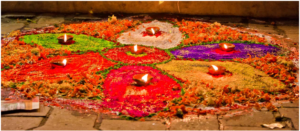
They dedicate the first day of Tihar to crows, the winged acquaintances of humans who is omnipresent and yet its presence is often ignored. According to religious belief, crows are the messenger of Yamraj, the God of death and are worshipped to bring good luck. But crows also play an important role in the ecosystem specially in the cities as the flying detritivore that devours our wastes on a daily basis. On this day of the crows or ‘Kaag Tihar’, these creatures are paid a tribute by leaving food and water for them on the rooftops. If the food and water is gone by the end of the day it is seen as a blessing to the family.
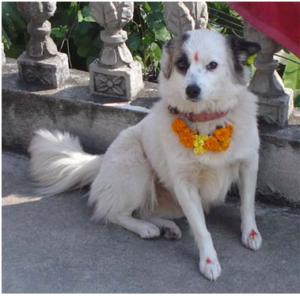
The second day is meant to worship dogs, the ‘Kukur Tihar’. According to mythology, two four eyed dogs are the guards of the gate to hell. But on this day they are worshipped for their cherished relation with humans. It is a way to express the gratitude for their loyalty and friendship. On this day, both dogs of the house and stray are worshipped with garlands and a red mark on the forehead or tika. It is a sign of sacredness and acts as a blessing to anyone who encounters that dog for the day. They are also offered delicious food. This is the one day in the year when even the stray dog gets the best of the meals.
The third day is meant for the worship of cow or the ‘Gai Tihar’. In Hinduism, cows are a symbol of prosperity and wealth thus it is no surprise that Lakshmi Puja is also celebrated later on this day. On this day, cows are washed and worn garlands made of marigold. They are fed the best grass. Houses are cleaned and the doorways and windows are decorated with garlands made of Saya Patri (marigolds) and makhamali (Gomphrena globosa) flowers. In the evening, the houses are lit with earthen lamps or diyas to welcome Lakshmi, the Goddess of wealth and is worshipped and thanked for the prosperity and wealth bestowed upon the family. At night the girls enjoy dancing and visiting all the houses in the neighborhood with musical instruments singing and dancing to their traditional song known as Bhailo all night long collecting money, fruits and a delicacy called selroti as a tip from houses and share the bounty amongst themselves.
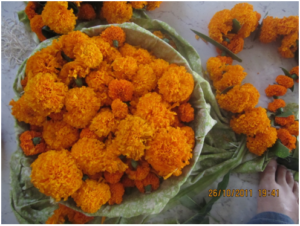
On the fourth day there are three pujas. The first one is the worship of the ox or the ‘Goru Tihar’. On this day ox is offered food and taken blessings from. Then the Vaishnav community celebrate Govardhan puja that is the worship of Govardhan mountain. Mythologically, Lord Krishna lifted this whole mountain on his pinky to save his villagers from the wrath of Indra, the God of the heavens. On this day a heap of dried cow dung is worshipped as a representation of the Govardhan Mountain. Also the majority of the Newar community on the night of the fourth day perform Mha Puja ,worship of self, by treating themselves to new clothes and delicacies. This day is also seen as the beginning of the new Nepal Sambat calendar year.
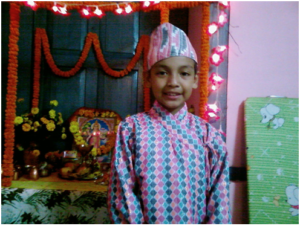
The fifth day is meant to cherish the relation between siblings. According to mythology, Lord Yamraj visited his sister Goddess Yamuna and received a tilak, garland and special food made by her. They exchanged gifts to mark their love and respect and Yamraj announced that whoever receives a tilak from his sister will not die on this day. The sisters offer garlands made of flower that doesn’t wilt quickly to their brother symbolizing that their prayers will last long. The brothers sit on the floor while their sisters perform their puja by circling their brothers, dripping oil on the floor from a copper pitcher and applying oil to their brother’s hair, following with a seven-color tikas which is applied on the brother’s forehead. Next, brothers give tikas to their sisters in the same fashion with an exchange of gifts. This ritual is practiced regardless of who amongst the siblings is the older one. Those without a sister or brother join relatives or friends for tika.
In this way, Nepali Tihar is a culmination of love and respect for all beings of nature. So let us celebrate this Diwali with less crackers and more love!







